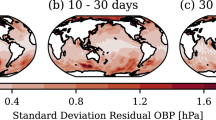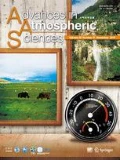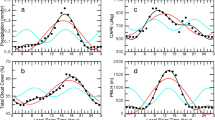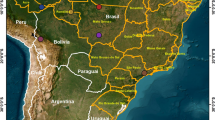Abstract
Atmospheric InfraRed Sounder (AIRS) measurements are a valuable supplement to current observational data, especially over the oceans where conventional data are sparse. In this study, two types of AIRS-retrieved temperature and moisture profiles, the AIRS Science Team product (SciSup) and the single field-of-view (SFOV) research product, were evaluated with European Centre for Medium-Range Weather Forecasts (ECMWF) analysis data over the Atlantic Ocean during Hurricane Ike (2008) and Hurricane Irene (2011). The evaluation results showed that both types of AIRS profiles agreed well with the ECMWF analysis, especially between 200 hPa and 700 hPa. The average standard deviation of both temperature profiles was approximately 1 K under 200 hPa, where the mean AIRS temperature profile from the AIRS SciSup retrievals was slightly colder than that from the AIRS SFOV retrievals. The mean SciSup moisture profile was slightly drier than that from the SFOV in the mid troposphere. A series of data assimilation and forecast experiments was then conducted with the Advanced Research version of the Weather Research and Forecasting (WRF) model and its three-dimensional variational (3DVAR) data assimilation system for hurricanes Ike and Irene. The results showed an improvement in the hurricane track due to the assimilation of AIRS clear-sky temperature profiles in the hurricane environment. In terms of total precipitable water and rainfall forecasts, the hurricane moisture environment was found to be affected by the AIRS sounding assimilation. Meanwhile, improving hurricane intensity forecasts through assimilating AIRS profiles remains a challenge for further study.
Similar content being viewed by others

References
Atlas, R., 2005: The impact of AIRS data on weather prediction. Proc. SPIE 5806, Algorithms and Technologies for Multispectral, Hyperspectral, and Ultraspectral Imagery XI, 599 (July 13, 2005), doi: 10.1117/12.602540.
Aumann, H. H., and Coauthors, 2003: AIRS/AMSU/HSB on the Aqua mission: Design, science objectives, data products, and processing systems. IEEE Trans. Geosci. Remote Sens., 41(2), 253–264, doi: 10.1109/TGRS.2002.808356.
Avila, L. A., and J. Cangialosi, 2011: Tropical Cyclone Report — Hurricane Irene (AL092011). National Hurricane Center, 45 pp. [Available online at http://www.nhc.noaa.gov/2011atlan.shtml.]
Barker, D., and Coauthors, 2012: The weather research and forecasting model’s community variational/ensemble data assimilation system: WRFDA. Bull. Amer. Meteor. Soc., 93, 831–843.
Berg, R., 2009: Tropical Cyclone Report-Hurricane Ike (AL 092008). National Hurricane Center, 55 pp. [Available online at http://www.nhc.noaa.gov/2008atlan.shtml.]
Chahine, M. T., and Coauthors, 2006: AIRS: Improving weather forecasting and providing new data on greenhouse gases. Bull. Amer. Meteor. Soc., 87, 911–926. doi: 10.1175/BAMS-87-7-911.
Chen, S.-H., Z. Zhao, J. S. Haase, A. Chen, and F. Vandenberghe, 2008: A study of the characteristics and assimilation of retrieved MODIS total precipitable water data in severe weather simulations. Mon. Wea. Rev., 136, 3608–3628.
Clough, S. A., M. W. Shephard, E. J. Mlawer, J. S. Delamere, M. J. Iacono, K. Cady-Pereira, S. Boukabara, and P. D. Brown, 2005: Atmospheric radiative transfer modeling: A summary of the AER codes. Journal of Quantitative Spectroscopy and Radiative Transfer, 91, 233–244.
Derber, J. C., and W.-S. Wu, 1998: The use of TOVS cloud-cleared radiances in the NCEP SSI analysis system. Mon. Wea. Rev., 126, 2287–2299.
Divakarla, M., G. C. D. Barnet, M. D. Goldberg, L. M. McMillin, E. Maddy, W. Wolf, L. Zhou, and X. Liu, 2006: Validation of atmospheric infrared sounder temperature and water vapor retrievals with matched radiosonde measurements and forecasts. J. Geophys. Res., 111, D09S15, doi: 10.1029/2005JD 006116.
Emanuel, K. A., 1999: Thermodynamic control of hurricane intensity. Nature, 401, 665–669.
Fetzer, E. J., B. H. Lambrigtsen, A. Eldering, H. H. Aumann, and M. T. Chahine, 2006: Biases in total precipitable water vapor climatologies from Atmospheric Infrared Sounder and Advanced Microwave Scanning Radiometer. J. Geophys. Res., 111, DS09S16, doi: 10.1029/2005JD006598.
Hong, S.-Y., Y. Noh, and J. Dudhia, 2006: A new vertical diffusion package with an explicit treatment of entrainment processes. Mon. Wea. Rev., 134, 2318–2341.
Iacono, M. J., J. S. Delamere, E. J. Mlawer, M. W. Shephard, S. A. Clough, and W. D. Collins, 2008: Radiative forcing by long-lived greenhouse gases: Calculations with the AER radiative transfer models. J. Geophys. Res., 113, D13103, doi: 10.1029/2008JD009944.
Jedlovec, G. J., S. H. Chou, B. T. Zavodsky, and W. Lapenta, 2006: The use of error estimates with AIRS profiles to improve short-term weather forecasts. Proc. SPIE. 6233, Algorithms and Technologies for Multispectral, Hyperspectral, and Ultraspectral Imagery XII, 62331B (May 05, 2006), doi: 10.1117/12.665724.
Kain, J. S., 2004: The Kain-Fritsch convective parameterization: An update. J. Appl. Meteor., 43, 170–181.
Kawanishi, T., and Coauthors, 2003: The Advanced Microwave Scanning Radiometer for the Earth Observing System (AMSR-E), NASDA’s contribution to the EOS for global energy and water cycle studies. IEEE Trans. Geosci. Remote Sens., 41, 184–194.
Kummerow, C., W. Barnes, T. Kozu, J. Shiue, and J. Simpson, 1998: The tropical rainfall measuring mission (TRMM) sensor package. J. Atmos. Oceanic Technol., 15, 809–817.
Kwon, E.-H., J. Li, J. Li, B. J. Sohn, and E. Weisz, 2012: Use of total precipitable water classification of a priori error and quality control in atmospheric temperature and water vapor sounding retrieval. Adv. Atmos. Sci., 29(2), 263–273, doi: 10.1007/s00376-011-1119-z.
Leidner, S. M., L. Isaksen, and R. N. Hoffman, 2003: Impact of NSCAT winds on tropical cyclones in the ECMWF 4DVAR assimilation system. Mon. Wea. Rev., 131, 3–26.
Le Marshall, J., and Coauthors, 2006: Improving global analysis and forecasting with AIRS. Bull. Amer. Meteor. Soc., 87, 891–894.
Lee, Y.-K., Z. Li, J. Li, and T. Schmit, 2014: Evaluation of the GOES-R ABI LAP retrieval algorithm using the GOES-13 Sounder. J. Atmos. Oceanic Tech., 31, 3–19.
Li, J., and H.-L. Huang, 1999: Retrieval of atmospheric profiles from satellite sounder measurements by use of the discrepancy principle. Appl. Opt., 38, 916–923.
Li, J., and J. L. Li, 2008: Derivation of global hyperspectral resolution surface emissivity spectra from advanced infrared sounder radiance measurements. Geophys. Res. Lett., 35, L15807, doi: 10.1029/2008GL034559.
Li, J., and H. Liu, 2009: Improved hurricane track and intensity forecast using single field-of-view advanced IR sounding measurements. Geophys. Res. Lett., 36, L11813, doi: 10.1029/2009GL038285.
Li, J., W. Wolf, W. P. Menzel, W. Zhang, H.-L. Huang, and T. H. Achtor, 2000: Global soundings of the atmosphere from ATOVS measurements: The algorithm and validation. J. Appl. Meteor., 39, 1248–1268.
Li, J., W. P. Menzel, F. Sun, T. J. Schmit, and J. Gurka, 2004: AIRS sub-pixel cloud characterization using MODIS cloud products. J. Appl. Meteor., 43, 1083–1094.
Liu, H., and J. Li, 2010: An improvement in forecasting rapid intensification of typhoon Sinlaku (2008) using clear-sky full spatial resolution advanced IR soundings. J. Appl. Meteor. Climatol., 49, 821–827.
Lorenc, A. C., and Coauthors, 2000: The Met office global threedimensional variational data assimilation scheme. Quart. J. Roy. Meteor. Soc., 126, 2991–3012.
McCarty, W., G. Jedlovec, and T. L. Miller, 2009: Impact of the assimilation of Atmospheric Infrared Sounder radiance measurements on short-term weather forecasts. J. Geophys. Res., 114, D18122, doi: 10.1029/2008JD011626.
Migliorini, S., 2012: On the equivalence between radiance and retrieval assimilation. Mon. Wea. Rev., 140, 258–265.
Migliorini, S., C. Piccolo, and C. Rodgers, 2008: Use of the information content in satellite measurements for an efficient interface to data assimilation. Mon. Wea. Rev., 136, 2633–2650.
Miyoshi, T., and M. Kunii, 2012: Using AIRS retrievals in the WRF-LETKF system to improve regional numerical weather prediction. Tellus A, 64, 18408.
Morcrette, J. J., H. W. Barker, J. N. S. Cole, M. J. Iacono, and R. Pincus, 2008: Impact of a new radiation package, McRad, in the ECMWF integrated forecasting system. Mon. Wea. Rev., 136, 4773–4798.
O’Neill, L. L., D. B. Chelton, S. K. Esbensen, and F. F. Wentz, 2005: High-resolution satellite measurements of the atmospheric boundary layer response to SST variations along the Agulhas return current. J. Climate, 18, 2706–2723.
Parkinson, C. L., 2003: Aqua: An Earth-observing satellite mission to examine water and other climate variables. IEEE Trans. Geosci. Remote Sens., 41, 265–273.
Parrish, D. F., and J. C. Derber, 1992: The national meteorological center’s spectral statistical-interpolation analysis system. Mon. Wea. Rev., 120, 1747–1763.
Pu, Z., X. Li, and E. J. Zipser, 2009: Diagnosis of the initial and forecast errors in the numerical simulation of the rapid intensification of Hurricane Emily (2005). Wea. Forecasting, 24, 1236–1251.
Pu, Z. X., and L. Zhang, 2010: Validation of atmospheric infrared sounder temperature and moisture profiles over tropical oceans and their impact on numerical simulations of tropical cyclones. J. Geophys. Res., 115, D24114, doi: 10.1029/2010JD014258.
Reale, O., J. Susskind, R. Rosenberg, E. Brin, E. Liu, L. P. Riishojgaard, J. Terry, and J. C. Jusem, 2008: Improving forecast skill by assimilation of quality-controlled AIRS temperature retrievals under partially cloudy conditions. Geophys. Res. Lett., 35, L08809, doi: 10.1029/2007GL033002.
Reale, O., W. K. Lau, J. Susskind, E. Brin, E. Liu, L. P. Riishojgaard, M. Fuentes, and R. Rosenberg, 2009: AIRS impact on the analysis and forecast track of tropical cyclone Nargis in a global data assimilation and forecasting system. Geophys. Res. Lett., 36, L06812, doi: 10.1029/2008GL037122.
Roy, C., and R. Kovordányi, 2012: Tropical cyclone track forecasting techniques—A review. Atmospheric Research, 104–105, 40–69.
Skamarock, W.C., and Coauthors, 2008: A description of the Advanced Research WRF Version 3. NCAR Tech Note, NCAR/TN-475+STR, 113 pp. [Available online at http://www.mmm.ucar.edu/wrf/users/docs/arwv3.pdf.]
Simpson, J., R. F. Adler, and G. R. North, 1988: A proposed tropical rainfall measuring mission (TRMM) satellite. Bull. Amer. Meteor. Soc., 69, 278–295.
Smith, W. L., E. Weisz, S. Kirev, D. Zhou, Z. Li, and E. Borbas, 2012: Dual-regression retrieval algorithm for real-time processing of satellite ultraspectral radiances. J. Appl. Meteor. Climatol., 51, 1455–1476.
Strow, L. L., S. E. Hannon, S. De-Souza Machado, H. E. Motteler, and D. Tobin, 2003: An overview of the AIRS Radiative Transfer Model. IEEE Trans. Geosci. Remote Sens., 41, 303–313.
Strow, L. L., S. E. Hannon, S. De-Souza Machado, H. E. Motteler, and D. C. Tobin, 2006: Validation of the atmospheric infrared sounder radiative transfer algorithm. J. Geophys. Res., 111, D09S06, doi: 10.1029/2005JD006146.
Susskind, J., 2007: Improved atmospheric soundings and error estimates from analysis of AIRS/AMSU data. Proc. SPIE. 6684, Atmospheric and Environmental Remote Sensing Data Processing and Utilization III: Readiness for GEOSS, 66840M (September 13, 2007), doi: 10.1117/12.734336.
Susskind, J., C. Barnet, and J. Blaisdell, 2003: Retrieval of atmospheric and surface parameters from AIRS/AMSU/HSB data in the presence of clouds. IEEE Trans. Geosci. Remote Sens., 41, 390–409.
Susskind, J., C. Barnet, J. Blaisdell, L. Iredell, F. Keita, L. Kouvaris, G. Molnar, and M. Chahine, 2006: Accuracy of geophysical parameters derived from Atmospheric Infrared Sounder/Advanced Microwave Sounding Unit as a function of fractional cloud cover. J. Geophys. Res., 111, D09S17, doi: 10.1029/2005JD006272.
Susskind, J., J. M. Blaisdell, L. Irdell, and F. Keita, 2011: Improved temperature sounding and quality control methodology using AIRS/AMSU Data: The AIRS Science Team Version 5 retrieval algorithm. IEEE Trans. Geosci. Remote Sens., 49, 883–907, doi: 10.1109/TGRS.2010.2070508.
Susskind, J., J. Blaisdell, and L. Iredell, 2012: Significant advances in the AIRS Science Team Version-6 retrieval algorithm. Proc. SPIE 8510, Earth Observing Systems XVII, 85100U (October 15, 2012), doi:10.1117/12.929953.
Tobin, D. C., and Coauthors, 2006: Atmospheric radiation measurement site atmospheric state best estimates for Atmospheric Infrared Sounder temperature and water vapor retrieval validation. J. Geophys. Res., 111, D09S14, doi: 10.1029/2005JD006103.
Weisz, E., J. Li, J. Li, D. K. Zhou, H.-L. Huang, M. D. Goldberg, and P. Yang, 2007: Cloudy sounding and cloud-top height retrieval from AIRS alone single field-of-view radiance measurements. Geophys. Res. Lett., 34, L12802, doi: 10.1029/2007GL030219.
Weisz, E., W. L. Smith Sr., and N. Smith, 2013: Advances in simultaneous atmospheric profile and cloud parameter regression based retrieval from high-spectral resolution radiance measurements. J. Geophys. Res., 118, 6433–6443.
Wentz, F., and T. Meissner, 2004: updated daily: AMSR-E/Aqua L2B Global Swath Ocean Products Derived from Wentz Algorithm V002, September 2008. National Snow and Ice Data Center. Boulder, Colorado USA. [Available online at http://nsidc.org/data/ae ocean.html.]
Wentz, F. J., and T. Meissner, 2007: Supplement 1 Algorithm Theoretical Basis Document for AMSR-E Ocean Algorithms. RSS Tech. Report 051707, Remote Sensing Systems, Santa Rosa, California USA, 6 pp.
Won, Y.-I., 2008: Readme Document for AIRS Level-2 Version 5 Support Products. Goddard Earth Sciences Data and Information Services Center, National Aeronautics and Space Administration. 57 pp. [Available online at: http://disc.sci.gsfc.nasa.gov/AIRS/documentation/readmes/README.AIR-2SUP.pdf.]
Wu, L., and Coauthors, 2012: Relationship of environmental relative humidity with North Atlantic tropical cyclone intensity and intensification rate. Geophys. Res. Lett., 39, L20809, doi: 10.1029/2012GL053546.
Zavodsky, B. T., S. H. Chou, G. Jedlovec, and W. Lapenta, 2007: The impact of atmospheric infrared sounder (AIRS) profiles on short-term weather forecasts. Proc. SPIE 6565, Algorithms and Technologies for Multispectral, Hyperspectral, and Ultraspectral Imagery XIII, 65651J (May 07, 2007), doi:10.1117/12.718121.
Zhang, X., Q. Xiao, and P. Fitzpatrick, 2007: The impact of multisatellite data on the initialization and simulation of Hurricane Lili’s (2002) rapid weakening phase. Mon. Wea. Rev., 135, 526–548.
Zhou, D. K., W. L. Smith, X. Liu, A. M. Larar, S. A. Mango, and H.-L. Huang, 2007: Physically retrieving cloud and thermodynamic parameters from ultraspectral IR measurements. J. Atmos. Sci., 64, 969–982.
Author information
Authors and Affiliations
Corresponding author
Rights and permissions
About this article
Cite this article
Zheng, J., Li, J., Schmit, T.J. et al. The impact of AIRS atmospheric temperature and moisture profiles on hurricane forecasts: Ike (2008) and Irene (2011). Adv. Atmos. Sci. 32, 319–335 (2015). https://doi.org/10.1007/s00376-014-3162-z
Received:
Revised:
Accepted:
Published:
Issue Date:
DOI: https://doi.org/10.1007/s00376-014-3162-z



